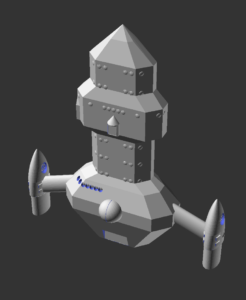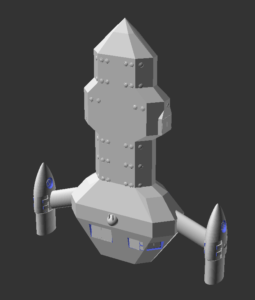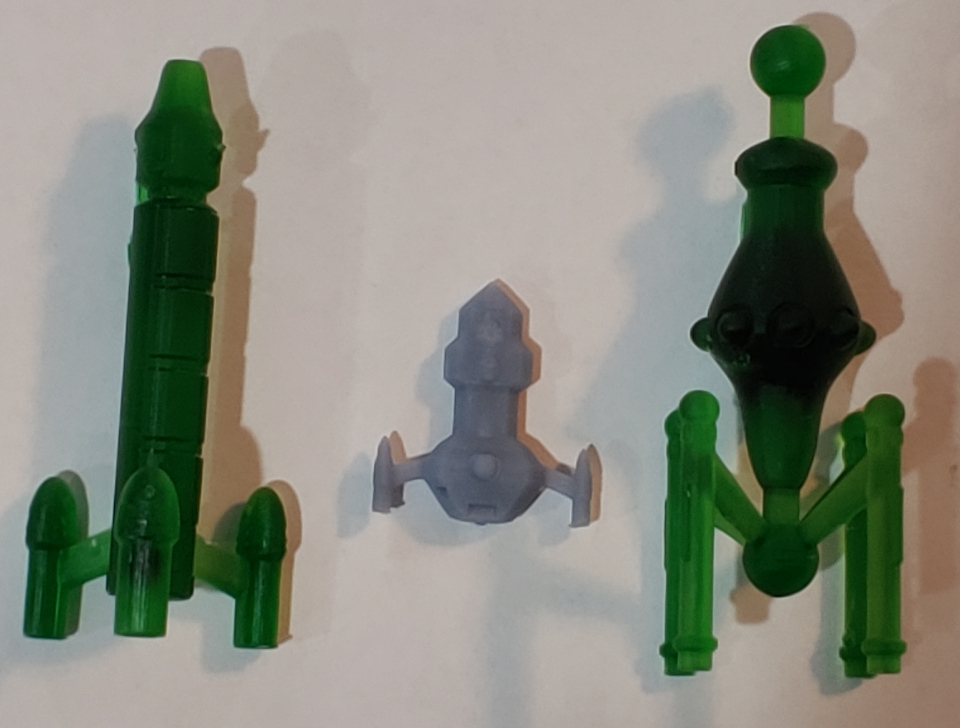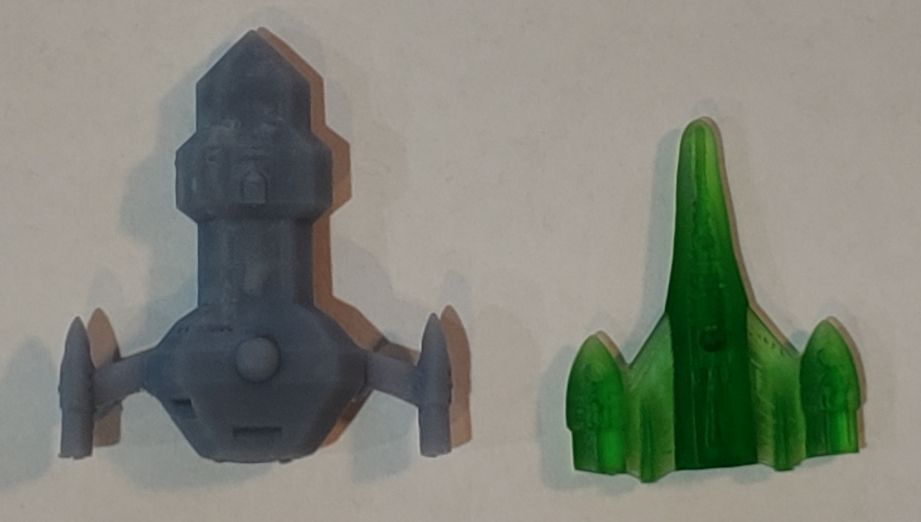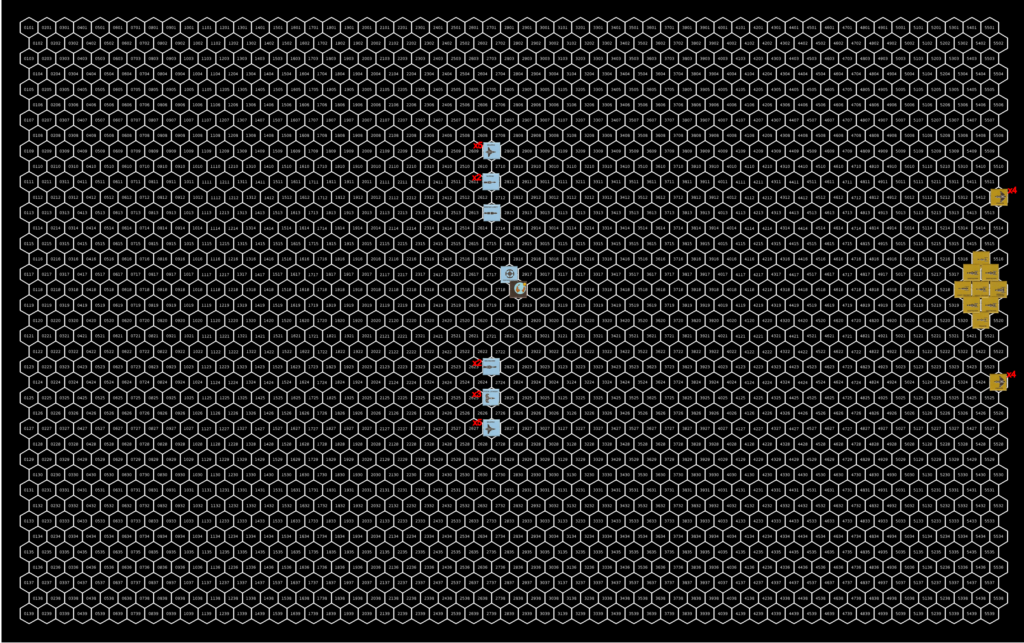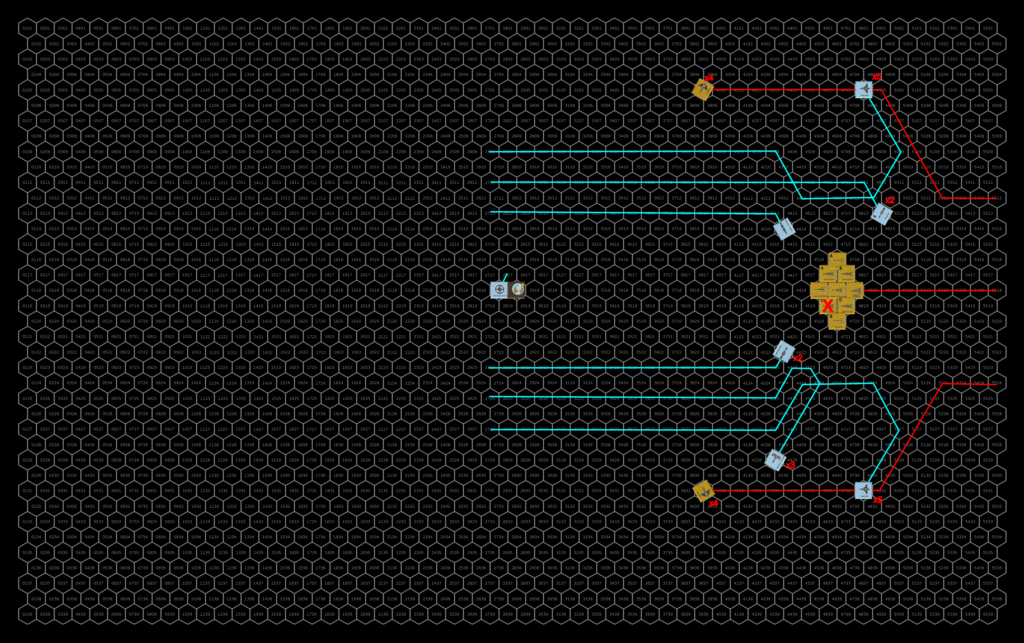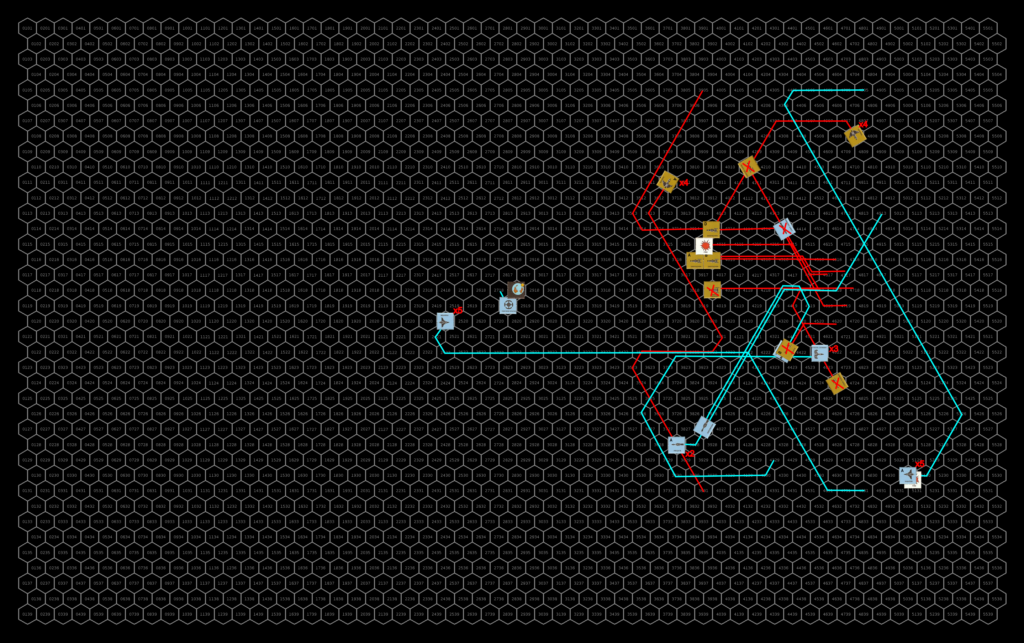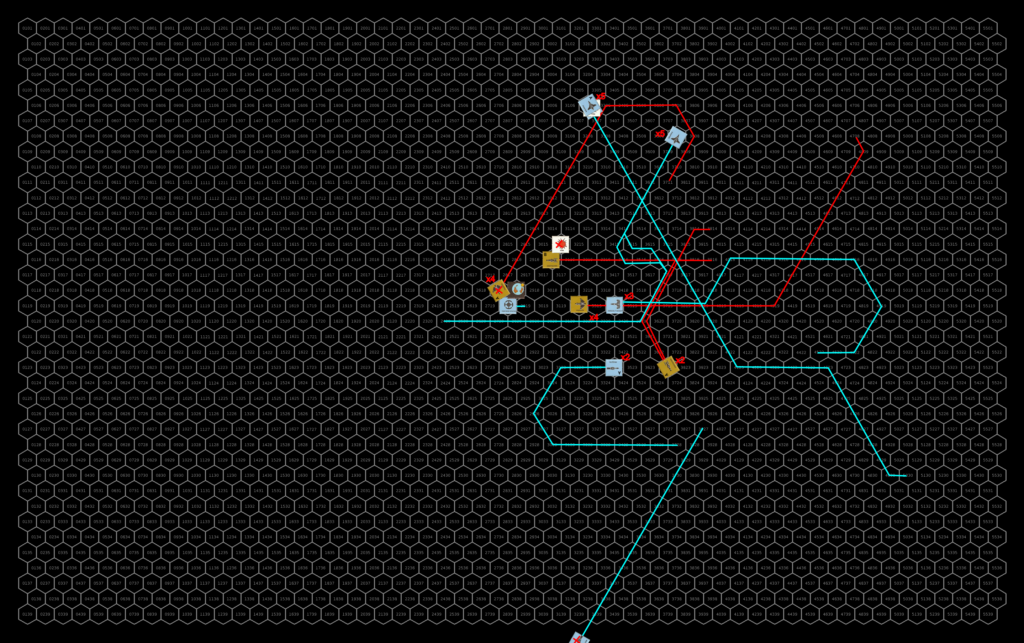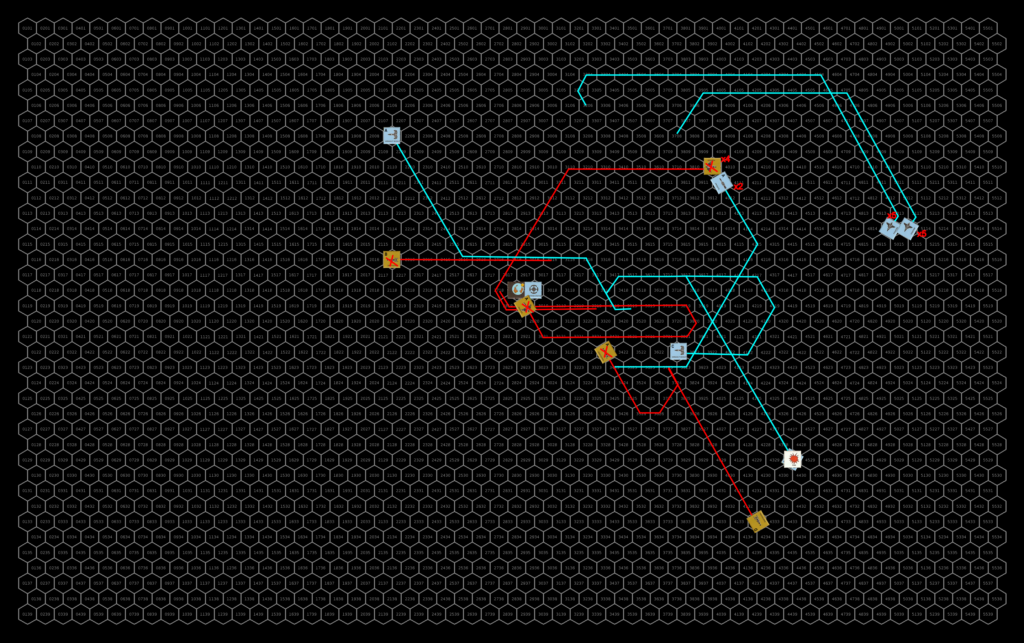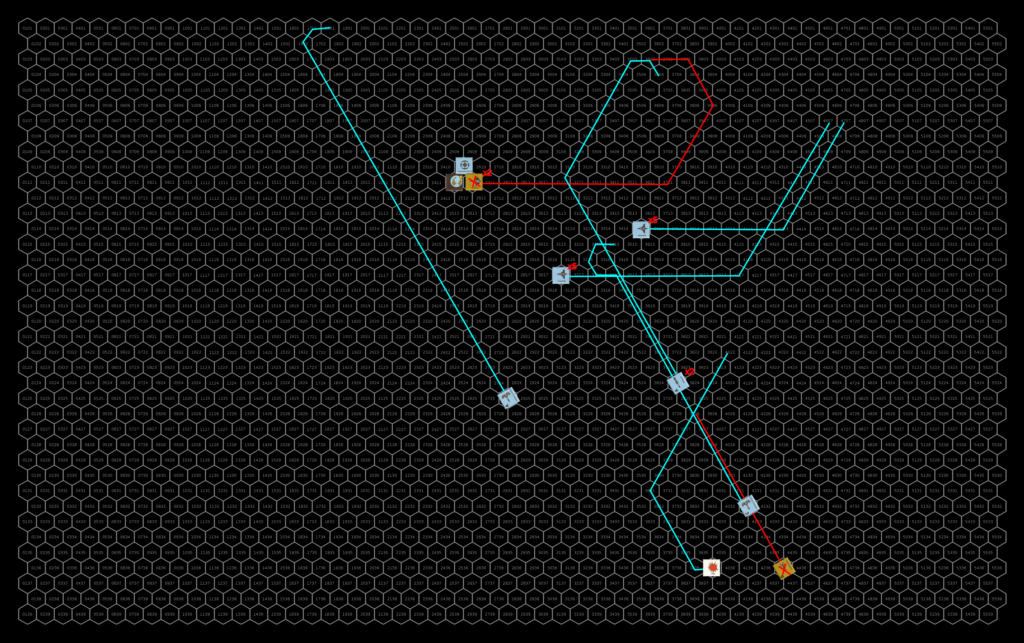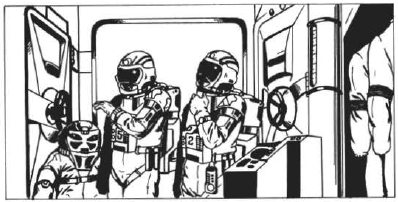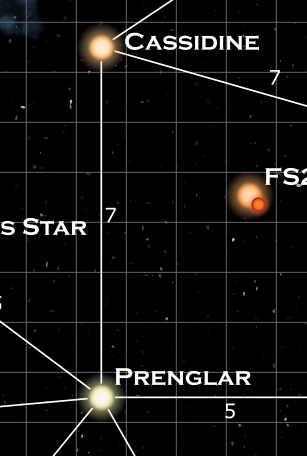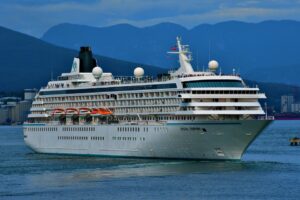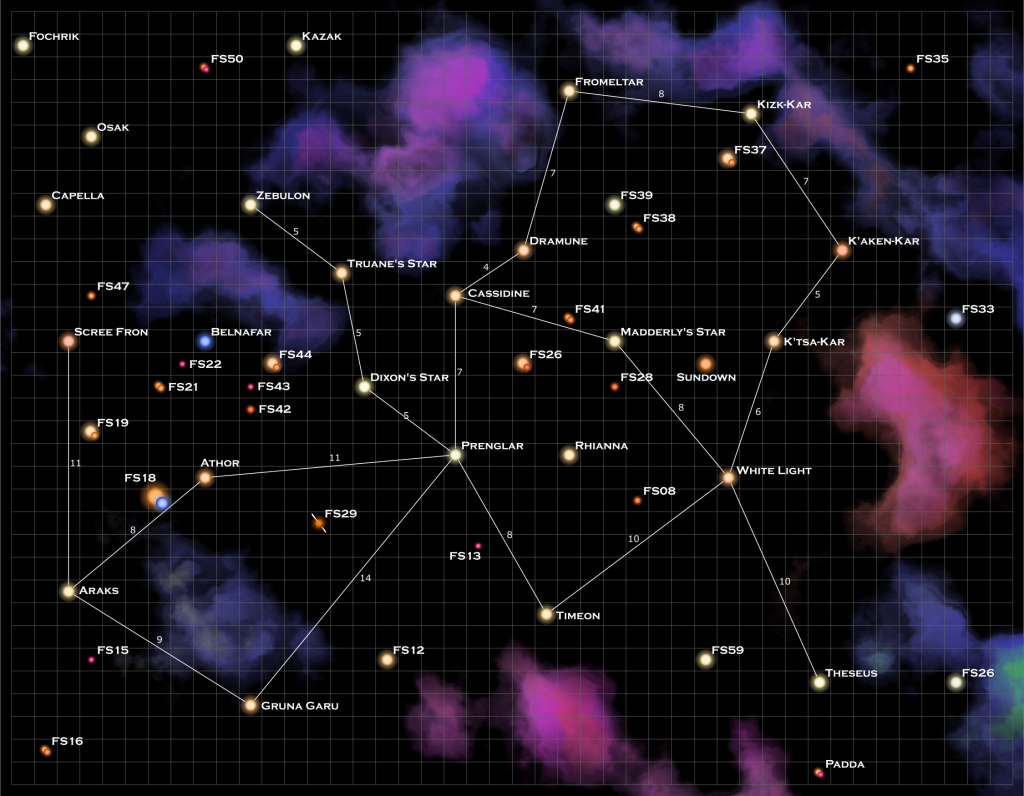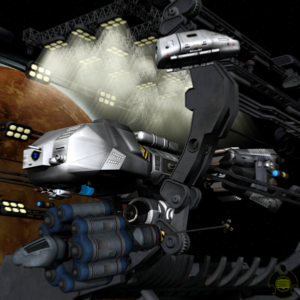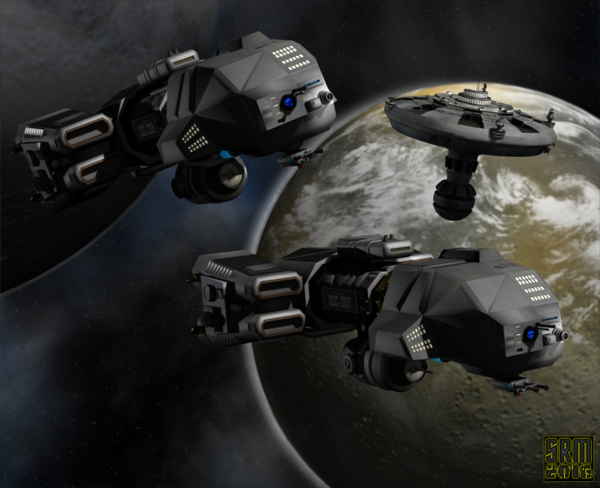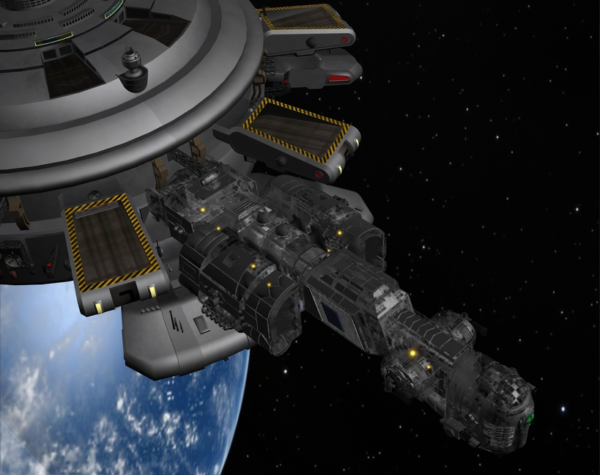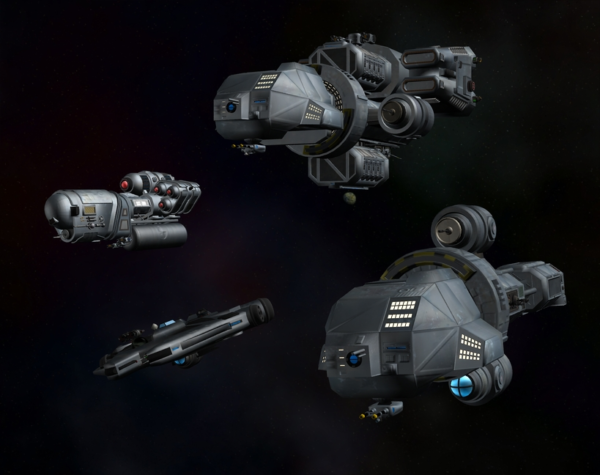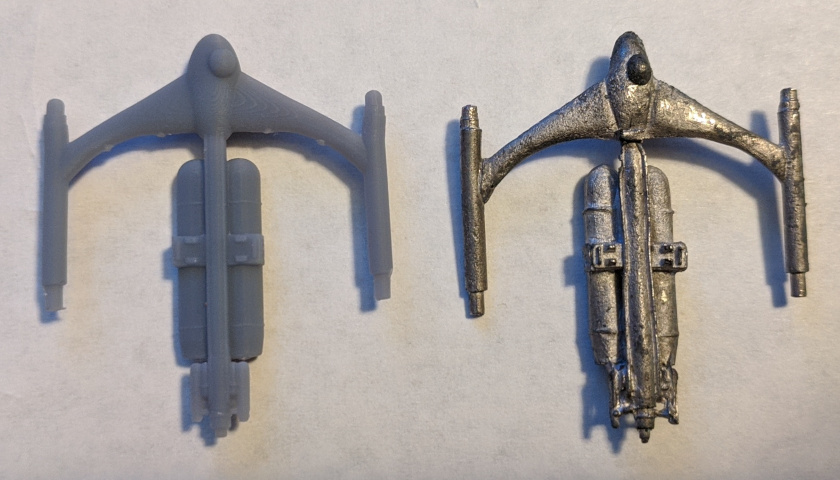I had planned to do an article on an alternate set of astrogation rules, but as I started looking at it, it was going to require more time than I had to get it done properly. So that one will come at some point in the future.
If you’re following the Star Frontiers Twitter feed, you know that yesterday started the main events of the Second Sathar War. A lot of my free time has been spent working on that and staying far enough ahead that I can get the battle posts up, track the ship movements, record and schedule repairs and new ship construction, and figure out strategy and tactics as they shift after each encounter. In fact, if I hadn’t posted it early to get some feedback, the Battle of Stenmar post I did a while back would have been today’s post as the tweet about that battle will be going up at some point today. Tracking all the ship movements and playing out the battles is keeping me busy. Who knew that managing a Frontier-wide battle for both sides would be so much work!
Given that the Second Sathar War narration is where my focus is right now, I thought I’d do a related post and talk about the Sathar starship construction centers (SCCs) in my version of the setting.
Some Background
Placing the SCCs
If you have looked closely at the Extended Frontier Map, you already know the locations of these SCCs – they are marked on the referee version of the map. And as I mentioned in the posts about the creation of that map, the sathar worlds and jump routes were originally laid down decades ago. I modified them slightly to account for the Zeb’s Guide data and fan material that I included in the map as the latter hadn’t been produced and I didn’t own a copy of the former when I made the original map as a teenager.
On that original map, only the first five SCCs were marked. I had originally created the map to help track the exact project I’m doing now as part of the Detailed Frontier Timeline, namely track the Second Sathar War from a ship construction and movement perspective with the RPG rules rather than the board game rules in in the Campaign Book. It was also made for a exploration campaign where the PC would go out to expand the borders of the Frontier and look for the sathar worlds but that’s a different set of posts. Because of that, I only included the five SCCs that I envisioned participating in the conflict and which is why those five, closest to the Frontier, have the first five numbers and not the ones deeper in sathar controlled space which arguably were created first. If I ever go back and rework everything, I might change the numbering.
When I was setting up the Detailed Frontier Timeline project and making the Extended Frontier Map, I realized that I needed to add in a few more SCCs in the other parts of sathar-controlled space to handle all the other ship construction needed by their empire. That got me up through the ninth SCC. I then realized they needed one to manage the fight against the Saurians and so added in the tenth one. So while they are numbered in order of creation, it was their creation in my head for the setting, not their creation dates in the timeline.
Sathar Ship Hull Sizes
Another item of note relative to the SCCs is the hull sizes I use for each of the sathar ships. These are slightly different than the values I use for the UPF ships but all fall within the range of sizes given for each class of ship on page 5 of the Knight Hawks Campaign Book. The sizes I use for the sathar ships are:
- Fighter – HS:1
- Cutter – HS:4
- Frigate – HS:5
- Destroyer – HS:6
- Light Cruiser – HS: 14
- Assault Carrier – HS:16
- Heavy Cruiser – HS: 18
In the timeline the cutter is a new ship type that will see action first in the Rim and later in the Frontier. The specs for the ship can be found on page 6 of Frontier Explorer issue 2.
It’s my take that the larger sathar ships are a bit bulkier than the corresponding UPF version. So sathar light cruisers are HS:14 while the UPF ones are HS:12, the sathar assault carriers are HS:16 while the UPF ones are HS: 14, and the sathar heavy cruiser is HS:18 compared to the single UPF heavy cruiser which is HS:16. Even the sathar destroyer is actually HS:6+ being just a bit larger than the standard HS:6 volume but not enough to actually be HS:7.
The reason for this is the role I have for these larger ships. In addition to being mainline fighting ships, the larger capital ships also double as troop transports. You can see this in the Sathar Destroyer Technical Manual. Someday I’ll detail out the light and heavy cruisers similarly. In any case, this makes the sathar ships a bit bulkier and take a bit longer to produce. They aren’t being used for the troop transport role at the beginning of the war but the capability is there. While this doesn’t have any impact on the actual battles, it does impact the starship construction centers and so needed to be spelled out.
The Starship Construction Centers
In this section, we will look at each of those starship construction centers in turn to talk about their capacity, production queues, and main focus.
If you’ve been following along with the Detailed Frontier Timeline and playing close attention, you could probably reconstruct the production queues of SSCs two through five as I’ve been posting the ships that were produced there as part of the timeline. SCC#1 has just come online and only produced a single ship (a light cruiser) so it’s full queue hasn’t been revealed and SCC#10 will soon be shifting from the Saurian conflict, which has ended, to the Second Sathar War. The first ship out of that SCC (a fighter) to participate in the SSW will complete construction in early December (FY61.304).
The production queues for SSCs one to five were specifically set up to try to produce the sathar Order of Battle from page 55 of the Knight Hawks Campaign Book at the time I started up the war in the timeline. I started with an initial semi-random “seed” of ships, modified for the encounters in the Detailed Frontier Timeline (like the fight a Volturnus), and then allowed the SSCs to crank out ships. I came pretty close with only a few more fighters (most of which I destroyed in the fight in the Liberty system) and one extra destroyer. I have a small computer program that allows me to run the production queues and add (and remove) SCCs as needed to produce the ships so I don’t have to do it by hand.
Okay, let’s look at these construction centers. Directions for the locations of the SCCs are given on the Extended Frontier map assuming the top of the map is “north.”
SCC#1
Location: OFS203 (“S” of Prenglar)
Capacity: 48 HS worth of ships
Production Queue:
- 42 HS of capacity dedicated to the production of light cruisers (3 under construction at any one time), staggered to produce a new LC every 140 days
- 6 HS of capacity dedicated to the production of destroyers, one every 180 days
Notes: This is the newest of the starship construction centers with its first ship being produced on FY61.208. It is at the far end on the sathar jump routes (without passing through the Frontier). It was constructed specifically to be a jump off and repair point to strike right into the heart of the Frontier at Prenglar.
The recent loss of SSC#2 and the Liberty system has actually isolated this SSC from the others. Ships produced here (or headed here) will have to pass through the Liberty system. This will give the UPF a chance to detect these ships if they try to get into the Frontier anywhere other than Prenglar.
SCC#2
Location: FS30 – now Liberty (“SE” of Theseus)
Capacity: 46 HS
Production Queue:
- 16 HS of capacity devoted to production of assault carriers, one very 480 days
- 24 HS of capacity devoted to production of destroyers (six under production at any one time), staggered to complete one every 45 days
- 6 HS of capacity split between production of fighters and destroyers. Produces 6 fighters in 30 days, then a destroyer 180 days later, than back to fighters.
Notes: This SCC has been operating for a while and is responsible for the production of most of the destroyers seen in the Frontier recently and present in the fleets in the initial attacks in the Second Sathar War and produced some that were used against the saurians. It was also the driving force behind the exploration that established the sathar jump routes over to SCC#1 and in to S’esseu space.
In the notes in the SFKH4 module The War Machine (the Beyond the Frontier series), it said that this SCC was responsible for about 20% of the ships in the second sathar war. This is why I went with five SCCs when creating the original map.
This SCC was lost just recently along with a large number of fighters in the events of the SFKH4 module which wrapped up on FY61.40, only 40 days before the first sathar ships appeared in the Frontier to start the Second Sathar War. It will be interesting to see how things play out with the loss of this system, but that was always intended from the start.
SCC#3
Location: OFS138 (“NE” from Kizk-Kar)
Capacity: 59 HS
Production Queue:
- 54 HS of capacity devoted to heavy cruiser production (three under production at any one time), staggered to produce one HC every 180 days
- 5 HS of production dedicated to frigate production, one completed every 150 days
Notes: This is an older SCC as well and originally fueled the sathar exploration on the eastern side of the Frontier that resulted in the discovery of the saurians and the Mhemne.
Now focused on the battle with the Frontier, this SCC is responsible for the construction of the majority of heavy cruisers present in the early days of the conflict.
SCC#4
Location: OFS111 (“N” of Fromeltar)
Capacity: 49 HS
Production Queue:
- 16 HS of capacity dedicated to assault carrier production, one every 480 days
- 28 HS of capacity dedicated to light cruiser production (two under production at any one time), staggered to produce one every 210 days
- 5 HS of capacity dedicated to frigate and fighter production, completing 5 fighters in 30 days, then a frigate 150 days later and then back to fighters.
Notes: This is a older SCC established after the First Sathar War to explore more into the Frontier sector and the Rim. The route to Zebulon has been known for hundreds of years but most of the other routes are fairly new.
SCC#5
Location: OFS019 (“N” of Truane’s Star/Zebulon)
Capacity: 50 HS
Production Queue:
- 28 HS of capacity dedicated to light cruiser production (two under production at any one time), staggered to produce one every 210 days
- 18 HS of capacity dedicated to heavy cruiser production one every 540 days
- 4 HP of capacity dedicate to cutter production, one every 120 days
Notes: This is a newer SCC set up to provide ships for fighting in the Rim and the Frontier and built as part of the preparation for the Second Sathar War.
The cutter is a new ship that the sathar have developed partially in response to the UPF’s assault scout. It is not battle tested and at the start of the Second Sathar War, only 4 have been produced. They will see first blood in the Second Battle of Stenmar (coming on FY61.293).
SCC#6
Location: OFS117 (upper left center of Extended Frontier Map)
Capacity: 200 HS
Production Queue: Random, mostly non-military ships
Notes: This SCC is located in orbit around what in my game is the sathar homeworld. It is larger than even the largest SCC in the Frontier but is not currently involved in the SSW conflict, although that may change. This SCC primarily is responsible for producing “civilian” ships that the sathar use for non-military purposes.
It did, however, supply the ships that comprised SBF-F1 and SBF-F2 that attacked Stenmar (in the Kazak system) in the Detailed Frontier Timeline. Since those battles were outside the scope of the simulation I was working on (I’m ignoring the Rim), I had the ships for the fight in the Rim come from somewhere other than the five main SCCs.
SCC#7
Location: OFS101 (upper right of Extended Frontier Map)
Capacity: 75 HS
Production Queue: random, “civilian” ships
Notes: This is a new SCC and is currently focused on producing “civilian” ships and ships for exploration to the “NE” of the sathar homeworld. Not currently involved in SSW production.
SCC#8
Location: OFS097 (“N” of OFS117)
Capacity: 75 HS
Production Queue: random, “civilian” ships
Notes: This is another SCC that is producing civilian ships for the day-to-day operation of the sathar worlds. Not currently involved in SSW production.
SCC#9
Location: OFS064 (upper center of Extended Frontier Map)
Capacity: 75 HS
Production Queue: random, military and exploration vessels
Notes: This SCC is focused on an active campaign to explore the upper left corner of the Extended Frontier Map. It was ships from this system that many years ago discovered the Tetrach complex on OFS070 that the Discovery Squadron went looking for and which was contacted by the complex on Laco (Dixon’s Star) back at the end of FY59. It was actually this signal, plus the events of Volturnus, that kicked off the Second Sathar War.
The sathar are currently trying to find a way through the large nebula in this region as they have detected signals from another race on the other side of the nebula that they intend to conquer. It is not currently producing ships for the SSW and probably will not be used for that purpose at it is focused on a different threat.
SCC#10
Location: OFS174 (“E” of White Light)
Capacity: 60 HS
Production Queue:
- 18 HS of capacity dedicated to heavy cruiser production, one every 540 days
- 16 HS of capacity dedicated to assault carrier production, one every 480 days
- 14 HS of capacity dedicated to light cruiser production, one every 420 days
- 6 HS of capacity dedicated to destroyer production, one every 180 days
- 5 HS of capacity dedicated to frigate production, one every 150 days
- 1 HS of capacity dedicated to fighter production, one every 30 days
Notes: This SCC is producing some of every type of main-line sathar warship. For the past several years, it has been focused on the war with the saurians and is responsible for producing most of the ships that destroyed their worlds.
Being already focused on military production, and with the campaign against the saurians now ended (finished on FY61.282) and the loss of the SCC in the Liberty system, this SCC will shortly be added to war effort against the Frontier (officially on FY61.296).
Last Thoughts
Those are the sathar starship construction centers scattered about. All told, there are 737 HS of capacity across the 10 SCCs. It’s about 45% more capacity than in the Frontier, although more spread out. It is also more focused on military ships. The UPF has 430 HS of capacity that can produce military vessels and another 80 HS of capacity that can produce civilian ships and do maintenance.
As the battles play out, the sathar may shift the production queues to different mixes going forward (e.g. they have lost most of their destroyer production) but we’ll have to see how the upcoming battles play out. Look for the first play report later this week and running into next week as the initial battles occur around the Frontier.
How do you see the sathar starship construction being set up and handled? Have you every attempted anything like this for your game? Or have you been more sensible and just hand-waved it? Share your thoughts in the comments below.

